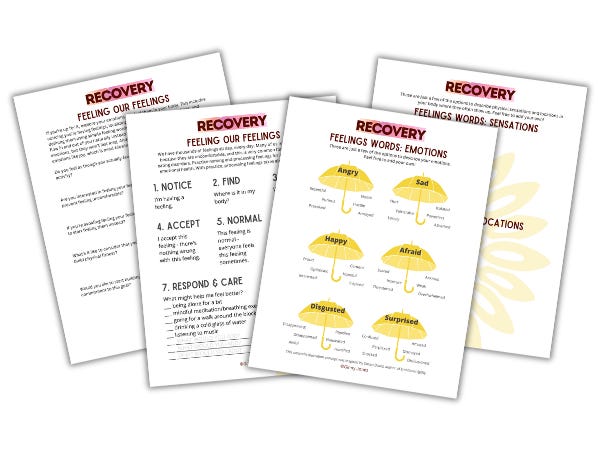My Emotional Strength Training Program (Because Feelings Are Hard)
Learning to feel feelings and regulate them in recovery is hard but worth the effort
It made sense to me that recovering from an eating disorder would change how I handle my body. But I was not prepared for needing to change how I handle my emotions, too.
My eating disorder was a powerful emotional regulator. It was only in recovery that I realized that without it I was a weakling when it came to the heavy lifting of feeling feelings.
I thought recovery would be about accepting my body as it is. I knew that developing hunger, fullness, and appetite cues would take time and practice. And those were indeed necessary and challenging.
But I didn’t know the hardest workouts in my recovery would be emotional.
Chronologically I was 40 but without the shielding cloak of my eating disorder behaviors, emotionally I felt like a toddler. The smallest obstacle—a grumpy waiter, a bad driver, the gentlest question—sent me collapsing into tears, running away, or ramping up to rage in a millisecond.
An eating disorder isn’t just about what we do with food. It’s also about what we do with the parts of us that are uncomfortable and inconvenient, including big feelings.
Before I learned to restrict food, I was already restricting my emotions. Before I learned to avoid calories, fat, carbs, and sugar, I learned to avoid anger, irritation, envy, longing, and so much more.
I didn’t realize I was using my eating disorder as an emotional regulator until the day I stopped. Then all the feelings it had been controlling hit me like a tidal wave. I needed to learn how to feel ASAP!
It was so hard!
Feeling feelings is entirely different than thinking and talking about them. Emotions live in our bodies. They’re sensations, like pulsing, vibrating, heat, cold, ringing, fluttering, and tension. We feel them in places like our skull, neck, back, gut, lungs, and heart.
Learning to regulate emotions is a developmental stage that’s derailed by an eating disorder. Just like learning to ride a bike as an adult, building emotional regulation skills as an adult is absolutely possible, but it’s harder than doing it as a child. For me it was definitely worth it.
All my years of pursuing fitness goals were a good model for building emotional strength. I knew it would take time and would make me sweat, but with time and patience I knew I could increase my emotional strength and resilience.
I kept my training program simple. I asked myself to do just three things:
Notice when I’m having a feeling.
Locate the feeling in my body, observe it using my senses, and define it with single words like pain, heat, pulsing, sinking, terror, despair, and fury.
Feel the feeling without using my eating disorder behaviors or other avoidance strategies.*
*Of course I can’t feel all my feelings all the time. If a feeling is going to bring me to my knees and I’m in the middle of working, parenting, or the grocery store, I delay emotional processing until later. But I’m committed to not using certain behaviors to cope with the delay, and to always return to the feeling, even when I don’t want to.
Feeling feelings takes practice, but over time it becomes easier and more natural. I started small and made it a habit. Over time, I gradually increased my emotional fitness and today I’m able to handle my feelings pretty well most of the time.**
**Perfectionist me would think I need to handle my feelings perfectly all of the time, but life is so much better without those sorts of expectations!
While feeling negative feelings really sucks for a minute or so, they always pass. And there’s an upside to all this work. I’ll never forget the first time as an adult I really felt a powerful positive emotion. I was sitting on the couch with my family, and suddenly I felt tingling wave moving through my whole body.
At first I didn’t know what it was. I was worried it was another negative feeling I had to process, but this time I was smiling and my eyes were shining. I took a few seconds to figure it out and then, somewhere deep in my body, I knew it was joy!
Tears sprang to my eyes and my daughter rolled her eyes lovingly and said, “Oh, here we go again–Mom’s having feelings!” We giggled as tears of joy fell around my big grin.
That single moment and many more since have made this journey well worth the effort.
🤔 What about you?
How do you feel about feeling your feelings? Are you interested in building your capacity to feel and process your emotions?
If you’re a paid subscriber, I’ve got a printable worksheet for you that will help.
Keep reading with a 7-day free trial
Subscribe to Recovery by Ginny Jones to keep reading this post and get 7 days of free access to the full post archives.





